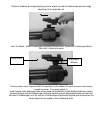
Venus--just like the moon, Venus changed phases from month to month. Some views of brilliant Venus appear
as if you were looking at a distant crescent moon.
Nebulae--The Great Orion Nebula is a very well known night sky object. This and many others are brought to you
by this telescope.
Star Clusters--View millions of stars densely packed in a cluster that resembles a ball.
Galaxies--One of the greatest and most interesting galaxies is our neighbor the Andromeda Galaxy. Enjoy this
and many others.
Much, much, more!
For further questions or additional information please contact:
Bushnell Sports Optics Worldwide
9200 Cody
Overland Park, KS 66214
www.bushnell.com
ANSWERS TO COMMONLY ASKED QUESTIONS
1. The image I see in the telescope is upside down
and reversed from right to left?
• An upside-down and reversed image is a
common characteristic of most astronomical
telescopes. Try using the enclosed erecting
eyepiece and penta mirror to remedy this
problem.
2. How do I determine the power my telescope? • The power of your telescope can be determined
by dividing the focal length of the objective lens
by the focal length of the eyepiece. The
eyepiece focal length is the number printed on
the eyepiece. (For example: 1000 ÷ 25 = 40X)
3. Where do I find the Telescope Focal Length • The telescope focal length is the same focal
length as the objective focal length. For this
telescope it is 750mm. Telescope focal lengths
range from 600mm to 900mm on Bushnell
Telescopes.
4. What can I see with my telescope? • Telescopes with power ranging from 25X to 50X
can be used to view Star Clusters and Nebulae.
90X to 120X telescopes can view galaxies. Most
planets can be seen at 150X and higher.
5. What do the numbers on the eyepiece mean? • The numbers on the eyepiece represents the
“focal length” of the eyepiece.












